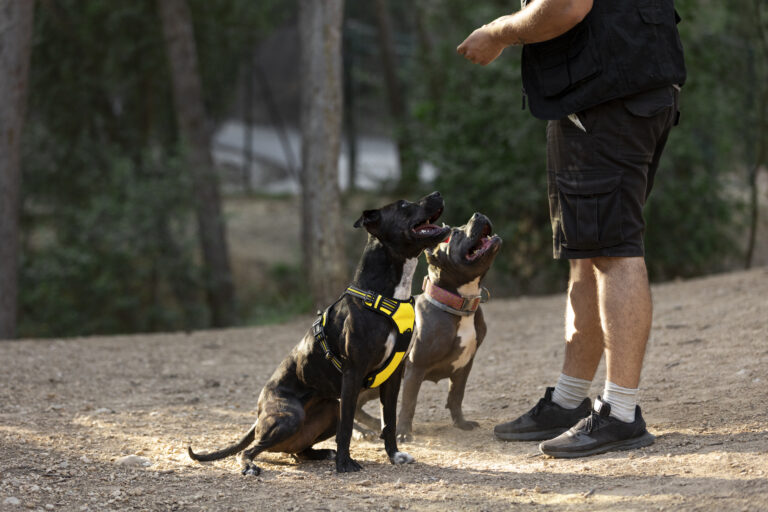What Are The Best Dog Training Methods – Northern Virginia
Many people have tried many different tricks and techniques with their dogs and they still wonder, “What is the best dog training method for training my dog?”
There are several training methods that can be used to train your dog. One of the most common and popular methods is reward-based or treat-based training. This training involves finding something that your dog really likes (ball, hot dogs, treats, tug) and using that as an incentive to get the dog to perform the desired command. The marker and treat training we discussed in the previous chapter is based on this method.
The pro to using this system with a dog who already knows the commands is that you have a dog who is very motivated for the reward. Therefore, they are voluntarily complying with your verbal commands in order to obtain the reward. The benefit of using this method to teach a dog a new command is he is very motivated, focused, and eager to please in order to obtain the reward. Often when using a food reward, the dog will be eager to continue training and learning for long periods of time. Look at it as giving a small kid one small piece of candy at a time every time he or she does something good. It is not enough to get full, but it is enough to make them want more. Another major pro to this system is that anyone can do it with no special knowledge or devices needed. Simply watch a video, grab a pack of hot dogs, and you are all set. That is why this is the most common method of training—any amateur can use this method to train a dog.
Anyone who has used this method for training can tell you that despite its numerous benefits, there are also several problems with it, as well. One of the main complaints with reward-based training is reliability. Remember, this system is based on the dog complying because he wants to get the reward. However, there will come a time when your dog does not want the reward or he is distracted by something more interesting than the reward. At that point, you have lost all obedience because your dog is no longer enticed to perform for the reward. As an example, if you are outside, off-leash with your dog and he spots a squirrel, a bird, or another dog, it will be much more interesting than the treat in your hand. When he is faced with a decision to go for the treat or take off after the squirrel, almost always the “prey” object will win. He will take off running to get the better reward and return when he loses interest in the item that initially distracted him.
The other problem with this system is that there is no consequence for disobedience, meaning, when your dog takes off down the road and will not come back, there is not much you can do in order to give him a consequence for bad behavior. Imagine training a child solely based on positive reinforcement; you get a treat if you do well, you don’t get a treat if you misbehave. The child would disobey fairly regularly. Your dog will do the same.
However, reward-based training is fun for you and your dog and it is a cheap, easy, and fast way to start teaching your dog a wide variety of commands with almost no expenses or specialized experience needed. You will be able to teach your dog commands and get decent results with obedience, but you will never have an amazingly obedient dog with this system.
Another popular training method is the prong collar. The prong collar is lined with metal prongs along the interior of the collar. The prong collar is designed to replicate the way the mother would correct her pups in a litter. Or how the alpha-male dog in a pack would correct lower-ranking members of the pack, which is giving a quick nip on the neck. When your dog does not comply with a command, give a quick jerk on the prong collar. Increase intensity of the jerk until your dog complies.
The pro to the prong collar is it is more reliable for obedience than the reward-based system. Using the prong collar, you can still use the reward-based system to motivate the dog, however, now you can use the prong collar to give an instant correction when the dog doesn’t listen with the reward-based system. A scenario would be if you had your dog’s favorite ball and you tell him to sit. If he doesn’t, you give a quick jerk on the prong collar and repeat the command. The prong collar gives him a less than pleasurable feeling and he complies with the command. If he does not comply with the command, increase the intensity of the jerk on the prong collar and repeat the command. This is done until the dog complies. Once he does, give the reward. The dog quickly learns, “If he says sit, I have to do it, so I might as well just do it the first time and get the reward.”
In my opinion, there are a few flaws with using the prong collar. One of the biggest is consistency of the correction given, meaning, is your dog being corrected at the same level of correction each day? If you correct your dog with the prong collar, is your correction (jerking on the prong collar) harder or gentler than when your wife corrects your dog with it? Or, when you corrected your dog when he really started to get under your skin, did you correct him much harder than you did yesterday for doing the exact same thing? When it comes to training, there has to be consistency in order for the dog’s learning to be maximized.
The second major problem with the prong collar is when your dog is off-leash and away from you. If he is 100 yards away and you call him to come and he doesn’t, what do you do? Now, you are back to the same problem you had with the reward-based training—off-leash reliability. Even with the prong collar, neither an instant correction nor a consequence can be given once he is out of your reach.
Overall, prong-collar training is safe, cheap, effective, and very humane when done properly. It is much more effective and reliable than reward-based training, however, it still has a couple of shortfalls.
My preferred method for training dogs is the electronic collar (e-collar). The e-collar comes with a remote control that the owner carries. It is based on almost the same premise as that of the prong collar. It gives a subtle stimulation to the dog’s neck area that can be increased in intensity until the dog complies with the command. Modern e-collars are very safe, reliable, and effective when used properly. In fact, almost all police, military, and personal protection dogs are now trained using the e-collar. When using the e-collar, we also use reward-based training for the dog, generally in the form of a toy or praise.
The e-collar has numerous levels of stimulation so its use can be tailored to a specific dogs’ temperament and the level of distraction encountered. When the e-collar is used properly, the dog does not view it as a punishment, but views it as a training tool, much like a leash. More important, they actually grow to love it because they associate the e-collar with going outside, off-leash, and having fun. Where other training systems fall short, the e-collar picks up. The range of e-collars vary from 400 yards to two miles. With this system, if your dog is off-leash and you call him to come and he does not, you still can give an instant correction that increases in intensity until he complies with the command.
The e-collar is safe, very effective, and humane when properly used. The shortfalls of the e-collar is that they are much more costly than the other training methods; an average e-collar costs around $200. It is highly recommended that you seek a professional trainer before utilizing this training device. The e-collar can make a disobedient dog perform with amazing precision in a very short time, however, in untrained hands it can completely ruin a dog.
Overall, when choosing a training method for your dog, decide what is most important to you—cost, functionality, or reliability. Whatever method you choose, keep in mind that practice, patience, and consistency are important to achieve great results using any method.
www.offleashk9training.com
www.facebook.com/offleashk9
www.youtube.com/offleashk9training


